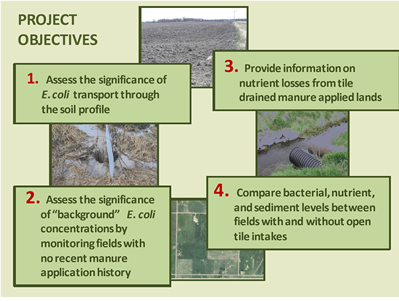
PROJECT OVERVIEW
PROJECT SUMMARY
Recent water quality monitoring conducted as part of the Blue Earth River Basin (BERB) Fecal Coliform Total Maximum Daily Load (TMDL) suggests that our understanding of bacterial, nutrient (nitrogen/phosphorus) and sediment transport dynamics from tile-drained agricultural lands in southern Minnesota may be insufficient. Data indicates that the BERB, a heavily drained agricultural watershed, is a significant contributor of bacteria, nutrients and sediment to surface waters. It is suspected that a significant portion of the nutrient and bacterial load from this watershed may originate from tile drained systems.
Funded by a 319 grant, the purpose of this project is to monitor manured and non-manured tile-drained agricultural lands with varying types of management strategies. Subsurface drainage improves crop growth and soil productivity, but can have detrimental effects by increasing the movement of agrichemicals to surface water supplies (Subsurface Drainage and Liquid Manure, Hoorman & Shipitalo, 2006). Understanding how agricultural management affects tile effluent is vital to the assessment and understanding of the row crop-dominated Minnesota River Basin (MRB). Many MRB impaired stream watersheds are 80-95% cultivated land. Modeling conducted by the Minnesota Pollution Control Agency (MPCA) indicates that a majority of flow in these streams originates from subsurface tile. Based on proportional volume, tile drainage has the potential to be a major contributor of bacterial, nutrient and sediment contributions to waterways.
This local applied research will strengthen decision making and ensure limited implementation resources are used wisely. Manure application (surface applied vs. incorporated), rate and timing (spring vs. fall applied) are being examined for their affects on bacterial and nutrient concentrations to tile effluent and are also being compared against effluent from fields with and without open intakes. Monitoring of fields without intakes is helping to assess pattern tile impacts, while monitoring non-manured fields is providing information about “background” bacteria levels.
1. Assess the significance of E. coli transport through the soil profile
2. Assess the significance of “background” E. coli concentrations by monitoring fields with no recent manure application history
3. Provide information on nutrient losses from tile drained manure applied lands
4. Compare bacterial, nutrient, and sediment levels between fields with and without open tile intakes
